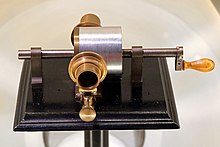Tin foil, also spelled tinfoil, is a thin foil made of tin. Tin foil was superseded after World War II by cheaper and more durable aluminium foil, which is still referred to as "tin foil" in many regions (an example of a misnomer).
History
Foil made from a thin leaf of tin was commercially available before its aluminum counterpart. In the late 19th century and early 20th century, tin foil was in common use, and some people continue to refer to the new product by the name of the old one. Tin foil is stiffer than aluminum foil. It tends to give a slight tin taste to food wrapped in it, which is a major reason it has largely been replaced by aluminum and other materials for wrapping food.
Because of its corrosion resistance, oxidation resistance, availability, low cost, low toxicity, and slight malleability, tin foil was used as a filling for tooth cavities prior to the 20th century.

The first audio recordings on phonograph cylinders were made on tin foil.
See also
References
- A.M. Howatson, P.G. Lund, and J.D. Todd, Engineering Tables and Data, p. 41
- "foil". Encyclopædia Britannica Online. Encyclopædia Britannica, Inc. Retrieved 27 February 2012.
- "Difference between Aluminum Foil and Tin Foil". DifferenceBetween.info. 23 April 2013. Retrieved 13 March 2014.
- "History Of The Use Of Tin Foil Pre 1850". Informational Site Network. Home Dentistry.ca. Retrieved 27 February 2012.
- The Encyclopedia Americana (Volume 22). Encyclopedia Americana Corporation. 1919. p. 792. Retrieved 8 January 2011.
This material-related article is a stub. You can help Misplaced Pages by expanding it. |